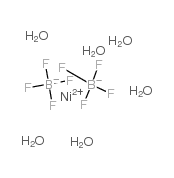Nickel(II) tetrafluoroborate hexahydrate
Modify Date: 2024-01-02 17:35:09

Nickel(II) tetrafluoroborate hexahydrate structure
|
Common Name | Nickel(II) tetrafluoroborate hexahydrate | ||
|---|---|---|---|---|
| CAS Number | 15684-36-3 | Molecular Weight | 340.39400 | |
| Density | N/A | Boiling Point | N/A | |
| Molecular Formula | B2F8H12NiO6 | Melting Point | N/A | |
| MSDS | N/A | Flash Point | N/A | |
| Name | Nickel(II) tetrafluoroborate hexahydrate |
|---|---|
| Synonym | More Synonyms |
| Molecular Formula | B2F8H12NiO6 |
|---|---|
| Molecular Weight | 340.39400 |
| Exact Mass | 340.00500 |
| PSA | 55.38000 |
| LogP | 2.21420 |
|
Section 1: Product Identification Chemical Name:Nickel (II) tetrafluoroboratehexahydrate, 99% CAS Registry Number:15684-36-3 Formula:Ni(BF4)2.6H2O EINECS Number:None Chemical Family:halometallate salts Synonym:none
Section 2: Composition and Information on Ingredients IngredientCAS NumberPercentACGIH (TWA)OSHA (PEL) Title Compound15684-36-3100%0.1mg/m3 (as Ni)1mg/m3 (as Ni) Section 3: Hazards Identification Emergency Overview:Irritating to skin, eyes and mucous membranes. May cause cancer. Primary Routes of Exposure:Ingestion, inhalation of dust Eye Contact:Causes slight to mild irritation of the eyes. Skin Contact:Causes slight to mild irritation of the skin. Inhalation:Irritating to the nose, mucous membranes and respiratory tract. Ingestion:Ingestion may lead to dizziness, abdominal cramps, vomiting, bloody diarrhea, weakness, and convulsions. Acute Health Affects:Irritating to skin, eyes and respiratory tract. Prolonged exposure to nickel and nickel compounds may lead to skin irritation and dermatitis, and affect Chronic Health Affects: kidney, liver, and lung function. May cause cancer. NTP:Yes IARC:Yes OSHA:No SECTION 4: First Aid Measures Immediately flush the eyes with copious amounts of water for at least 10-15 minutes. A victim may need Eye Exposure: assistance in keeping their eye lids open. Get immediate medical attention. Wash the affected area with water. Remove contaminated clothes if necessary. Seek medical assistance if Skin Exposure: irritation persists. Remove the victim to fresh air. Closely monitor the victim for signs of respiratory problems, such as difficulty Inhalation: in breathing, coughing, wheezing, or pain. In such cases seek immediate medical assistance. Seek medical attention immediately. Keep the victim calm. Give the victim water (only if conscious). Induce Ingestion: vomiting only if directed by medical personnel. SECTION 5: Fire Fighting Measures Flash Point:not applicable Autoignition Temperature:none Explosion Limits:none Extinguishing Medium:carbon dioxide, foam or dry powder If this product is involved in a fire, fire fighters should be equipped with a NIOSH approved positive pressure Special Fire Fighting Procedures: self- contained breathing apparatus and full protective clothing. Hazardous Combustion andIf involved in a fire this material may emit toxic and corrosive fumes. Decomposion Products: Unusual Fire or Explosion Hazards: No unusual fire or explosion hazards. SECTION 6: Accidental Release Measures Small spills can be mixed with vermiculite, sodium carbonate or other suitable non combustible adsorbent and Spill and Leak Procedures: swept up. SECTION 7: Handling and Storage Handling and Storage:Store in a cool, dry place in a tightly sealed container. SECTION 8: Exposure Controls and Personal Protection Eye Protection:Always wear approved safety glasses when handling a chemical substance in the laboratory. Skin Protection:Wear protective clothing and gloves. Ventilation:Material may form a fine dust. If possible, handle the material in an efficient fume hood. If ventilation is not available a respirator should be worn. The use of respirators requires a Respirator Respirator: Protection Program to be in compliance with 29 CFR 1910.134. Ventilation:Material may form a fine dust. If possible, handle the material in an efficient fume hood. Additional Protection:No additional protection required. SECTION 9: Physical and Chemical Properties Color and Form:green xtl. Molecular Weight:232.23 (340.32) Melting Point:no data Boiling Point:no data Vapor Pressure:not applicable Specific Gravity:1.47 Odor:none Solubility in Water:very soluble SECTION 10: Stability and Reactivity Stability:air and moisture stable Hazardous Polymerization:no hazardous polymerization Conditions to Avoid:none Incompatibility:active metals Decomposition Products:hydrogen fluoride fumes SECTION 11: Toxicological Information RTECS Data:No information available in the RTECS files. Carcinogenic Effects:Carcinogen (as Ni) Mutagenic Effects:No data Tetratogenic Effects:No data SECTION 12: Ecological Information Ecological Information:No information available SECTION 13: Disposal Considerations Disposal:Dispose of according to local, state and federal regulations. SECTION 14: Transportation Shipping Name (CFR):Non-hazardous Hazard Class (CFR):NA Additional Hazard Class (CFR):NA Packaging Group (CFR):NA UN ID Number (CFR):NA Shipping Name (IATA):Non-hazardous Hazard Class (IATA):NA Additional Hazard Class (IATA):NA Packaging Group (IATA):NA UN ID Number (IATA):NA SECTION 15: Regulatory Information TSCA:Not listed in the TSCA inventory. SARA (Title 313):Title compound: See category code N495 for reporting. Second Ingredient:None SECTION 16 - ADDITIONAL INFORMATION N/A |
| Hazard Codes | T: Toxic; |
|---|---|
| Risk Phrases | R45 |
| Safety Phrases | 53-45-36/37/39-26 |
| RIDADR | UN3260 |
| Packaging Group | III |
| NICKEL TETRAFLUOROBORATE HEXAHYDRATE |
| nickel(2+),ditetrafluoroborate,hexahydrate |
| MFCD00150259 |
| EINECS 238-753-4 |